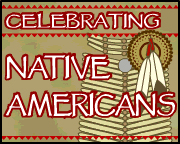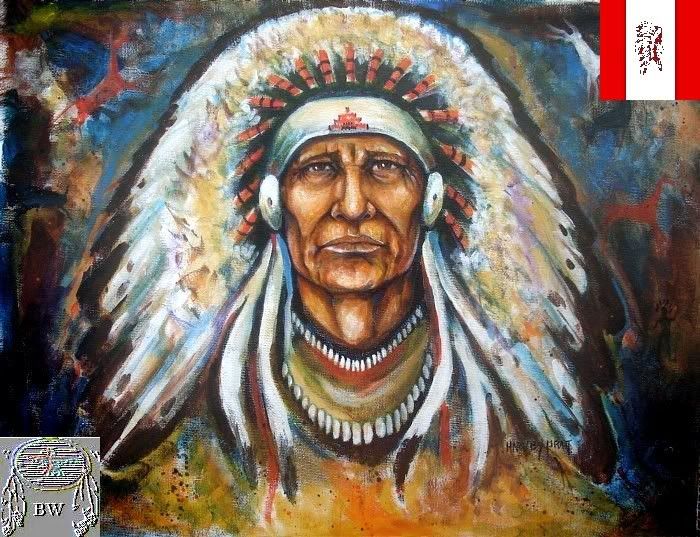|
BRAVEHORSE WARRIOR Hdamani
Sioux Warrior

 Chief Hdamani
Warrior Citation
H’DAMANI (Hadamane, Hydamani, Hdyamani, literally “walking bull” or “rattles as he walks,” also
known in his early years as Wigiya, meaning “yellow tent”), Santee Sioux chief, hunter, and trapper; b. c. 1831;
d. August 1912 on Oak Lake Indian Reserve, near Pipestone, Man. H’damani was a sub-chief of a Wahpeton Santee village
on the upper Minnesota River below Lac qui Parle (Minn.). Wiyan, his first wife, was a sister of the notorious rebel Wahpekute
chief Inkpaduta, responsible for the attacks at Spirit Lake (Iowa) in 1857 and an important participant in the Sioux uprising
of 1862. H’damani participated in both conflicts to a lesser degree than his volatile brother-in-law, who was hated
by both Caucasians and Sioux as vicious and treacherous. H’damani left his wife and young son (Edwin Phelps, who became
a Congregational missionary in South Dakota) and married Tunka; they would have three sons and two daughters who grew to adulthood.
In late 1862 he led 30 Wahpekute and Mdewakanton Santee families across the border into what is now southern Manitoba and,
after negotiating a purchase agreement with Ojibwas of the region, settled on the northwestern slopes of Turtle Mountain.
H’damani’s band was closely allied to several other Sioux bands which had moved into southwestern Manitoba, but
it had a strained relationship with that of Inkpaduta, who lived nearby while conducting guerrilla raids into American territory.
During the famous battle at Little Bighorn River in 1876, Inkpaduta led a strong force under Sioux chief Sitting Bull [Ta-tanka
I-yotank] and played a key role in defeating George Armstrong Custer. Afterwards, he returned for a while to the Canadian
side of Turtle Mountain with 60 families. On numerous occasions, rebelling American Sioux crossed over to seek sanctuary with
H’damani, who was deeply committed to living peacefully in Canada. No evidence exists that H’damani ever broke
that resolve.
Chief Hdamani
Warrior Citation
H’DAMANI (Hadamane, Hydamani, Hdyamani, literally “walking bull” or “rattles as he walks,” also
known in his early years as Wigiya, meaning “yellow tent”), Santee Sioux chief, hunter, and trapper; b. c. 1831;
d. August 1912 on Oak Lake Indian Reserve, near Pipestone, Man. H’damani was a sub-chief of a Wahpeton Santee village
on the upper Minnesota River below Lac qui Parle (Minn.). Wiyan, his first wife, was a sister of the notorious rebel Wahpekute
chief Inkpaduta, responsible for the attacks at Spirit Lake (Iowa) in 1857 and an important participant in the Sioux uprising
of 1862. H’damani participated in both conflicts to a lesser degree than his volatile brother-in-law, who was hated
by both Caucasians and Sioux as vicious and treacherous. H’damani left his wife and young son (Edwin Phelps, who became
a Congregational missionary in South Dakota) and married Tunka; they would have three sons and two daughters who grew to adulthood.
In late 1862 he led 30 Wahpekute and Mdewakanton Santee families across the border into what is now southern Manitoba and,
after negotiating a purchase agreement with Ojibwas of the region, settled on the northwestern slopes of Turtle Mountain.
H’damani’s band was closely allied to several other Sioux bands which had moved into southwestern Manitoba, but
it had a strained relationship with that of Inkpaduta, who lived nearby while conducting guerrilla raids into American territory.
During the famous battle at Little Bighorn River in 1876, Inkpaduta led a strong force under Sioux chief Sitting Bull [Ta-tanka
I-yotank] and played a key role in defeating George Armstrong Custer. Afterwards, he returned for a while to the Canadian
side of Turtle Mountain with 60 families. On numerous occasions, rebelling American Sioux crossed over to seek sanctuary with
H’damani, who was deeply committed to living peacefully in Canada. No evidence exists that H’damani ever broke
that resolve.
 In the early years the bands had lived by hunting, fishing, and trading furs at Fort Ellice and Upper Fort Garry (Winnipeg).
In the summer of 1877 H’damani travelled to White Horse Plain (St François Xavier) to ask Lieutenant Governor Alexander
Morris for a reserve. That year the four-section Oak Lake Indian Reserve was created, but H’damani and a number of families
refused to leave their beloved mountain foothills. The chief continued to press government officials. Consequently, despite
strong objections from some officials because of its proximity to the United States, the Department of the Interior had a
single section of land just north of the international border surveyed in 1886 and named Turtle Mountain Native American Reserve.
There was, however, no order in council confirming the reserve. Although some grain was grown and cattle raised at the Turtle
Mountain reserve, hunting, fishing, and trapping predominated. American transients considered unwelcome were forcibly removed
by the powerful chief, in later years with help from the North-West Mounted Police. From 1892 to 1895, the interdenominational
Christian Endeavour Society operated a school but after its bankruptcy native children were sent to a residential school in
Regina. H’damani’s family refused to send its children. Most Caucasian settlers liked and respected the old chief
and his dwindling band. Government officers repeatedly tried to shut the little reserve down and managed to induce three families
to move to Oak Lake in 1898 and five more in 1908. The members of the five remaining families listed as official residents
of Turtle Mountain, mostly old, infrm, and dying, were subjected to increasing pressure to release the reserve. On 9 Aug.
1909 three men voted for closure; H’damani and his grandson Chaske (Charlie Eagle) voted against. Only the male heads
of the five families had been allowed to vote and H’damani’s title of chief had been removed from the surrender
forms. Thus ended the tiny reserve. Indian affairs commissioner David Laird would discover the following year that eight others,
including some who had left the reserve earlier, should have been allowed to vote. Widowed, old, feeble, and homeless, H’damani
lived for some time on a reserve near Devils Lake, N.Dak., with his daughter Mazadusawin (Anna). He died while visiting relatives
at Oak Lake. The Turtle Mountain reserve was auctioned off to settlers; the funds resulting from the sale were allotted to
the five families as the government saw fit. In 1954 Oblate missionary Father Gontran Laviolette discovered a substantial
unpaid balance. In 1991 the Oak Lake band formally staked a claim to the Turtle Mountain reserve. From: historical accounts
& records
In the early years the bands had lived by hunting, fishing, and trading furs at Fort Ellice and Upper Fort Garry (Winnipeg).
In the summer of 1877 H’damani travelled to White Horse Plain (St François Xavier) to ask Lieutenant Governor Alexander
Morris for a reserve. That year the four-section Oak Lake Indian Reserve was created, but H’damani and a number of families
refused to leave their beloved mountain foothills. The chief continued to press government officials. Consequently, despite
strong objections from some officials because of its proximity to the United States, the Department of the Interior had a
single section of land just north of the international border surveyed in 1886 and named Turtle Mountain Native American Reserve.
There was, however, no order in council confirming the reserve. Although some grain was grown and cattle raised at the Turtle
Mountain reserve, hunting, fishing, and trapping predominated. American transients considered unwelcome were forcibly removed
by the powerful chief, in later years with help from the North-West Mounted Police. From 1892 to 1895, the interdenominational
Christian Endeavour Society operated a school but after its bankruptcy native children were sent to a residential school in
Regina. H’damani’s family refused to send its children. Most Caucasian settlers liked and respected the old chief
and his dwindling band. Government officers repeatedly tried to shut the little reserve down and managed to induce three families
to move to Oak Lake in 1898 and five more in 1908. The members of the five remaining families listed as official residents
of Turtle Mountain, mostly old, infrm, and dying, were subjected to increasing pressure to release the reserve. On 9 Aug.
1909 three men voted for closure; H’damani and his grandson Chaske (Charlie Eagle) voted against. Only the male heads
of the five families had been allowed to vote and H’damani’s title of chief had been removed from the surrender
forms. Thus ended the tiny reserve. Indian affairs commissioner David Laird would discover the following year that eight others,
including some who had left the reserve earlier, should have been allowed to vote. Widowed, old, feeble, and homeless, H’damani
lived for some time on a reserve near Devils Lake, N.Dak., with his daughter Mazadusawin (Anna). He died while visiting relatives
at Oak Lake. The Turtle Mountain reserve was auctioned off to settlers; the funds resulting from the sale were allotted to
the five families as the government saw fit. In 1954 Oblate missionary Father Gontran Laviolette discovered a substantial
unpaid balance. In 1991 the Oak Lake band formally staked a claim to the Turtle Mountain reserve. From: historical accounts
& records
|

